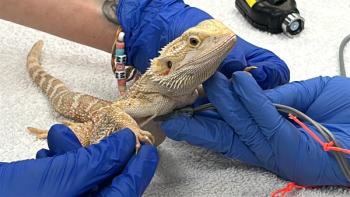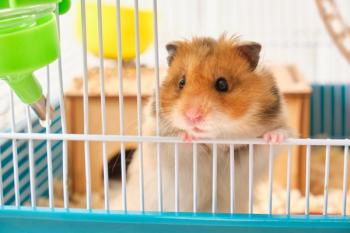
Amphibian husbandry for the veterinary clinician (Proceedings)
Amphibians are solidly represented as captives in both private and institutional collections. Many amphibian species are in precarious situations in their natural habitats due to environmental changes and disease. As a result, many captive populations are extremely valuable from a conservation standpoint.
Amphibians are solidly represented as captives in both private and institutional collections. Many amphibian species are in precarious situations in their natural habitats due to environmental changes and disease. As a result, many captive populations are extremely valuable from a conservation standpoint. For all of these reasons there is currently a strong need for capable amphibian veterinarians in both institutional and private practice. An important point to understand regarding amphibians is that although they are lumped with reptiles as "herptiles", in reality they are quite dissimilar. Amphibians are indeed vertebrates and ectothermic, however the similarities end there. Generally speaking, amphibians are less tolerant of husbandry problems than reptiles. Amphibians do not tolerate temperature fluctuations readily and are exquisitly sensitive to water balance problems and environmental toxins due to the permeable nature of their skin.
Housing
An in depth description of configuring vivaria for amphibians is beyond the scope of this abstract. The interested clinician is encouraged to read more complete references such as Amphibian Medicine and Husbandry by Wright and Whitaker (2001).
Captive amphibians typically do best when housed in complex, naturalistic vivaria that reflect the natural history of the species. Natural behaviors (including reproduction) are encouraged when the amphibian is able to interact with the environment appropriately. In addition, a properly constructed and stocked naturalistic vivarium will establish a biological cycle and require infrequent servicing. Alternatively, some species tolerate rather Spartan captive environments. These types of environments offer the advantages of being easier to keep clean and allow for more intense monitoring of individual animals. Hospital and quarantine vivaria are often minimalistic to allow easy care of the amphibian patient.
Large frogs and toads can be difficult to house appropriately due to their inclination to try and jump through clear barriers, which often leads to traumatic injury and infection. Enclosures need to be of appropriate size for these animals and ideally visual barriers should be employed to discourage them from jumping into the walls. Great care should be taken to avoid having sharp or abrasive surfaces in the amphibian vivarium. Amphibian skin is extremely delicate and can easily be damaged, potentially resulting in severe injury or introduction of infectious organisms.
Ventilation is important and an appropriate level is often difficult to maintain without sacrificing adequate levels of humidity (most species require around 70% humidity, though a humidity gradient is recommended). The keeper needs to tinker a bit with vivarium configuration in an effort to balance ventilation and humidity. With large collections housed in a designated room, humidifiers can be used effectively. Otherwise, manipulation of the amount of airflow in a vivarium can be accomplished by covering (or uncovering) ventilation ports, adding fans, etc. Also, addition of water features or misting systems can achieve humidity goals without sacrificing ventilation.
Basic substrate for most terrestrial amphibian vivaria can consist of a layer of pea gravel which may or may not be covered by sheet or sphagnum moss, leaf litter, mulch or soil. If simple gravel is chosen it should either be too large for the animal to ingest or small and smooth enough that it can be passed without complication. Soil is generally avoided, unless necessary to facilitate burrowing, as it typically goes foul more quickly than the other described substrates. It is best to avoid using peat moss or other acidic materials as the resultant pH of the substrate may be inappropriate for most species. Soft wood mulches (such as cedar) and those containing sharp or abrasive particles should be avoided for safety reasons. Substrates purchased from garden and home improvement stores should be free of pesticides, fertilizers and soil aerating materials such as perlite. Substrates can be collected from outdoor areas thought to be free of chemical contamination and can be treated via freezing for 2-3 weeks or heating in an oven to 200 F for 1-2 hours. A moisture gradient should be present within the substrate of the vivaria, which allows the amphibian to choose the appropriate conditions for its proximate needs. In general, substrate should be moist without being foul. Most natural substrates will need to be changed every 3-6 months to avoid bacterial build up.
In simple vivaria, the substrate can effectively consist of moistened, unbleached paper towels. The paper towels will need to be changed frequently as they quickly become unhygienic. For completely aquatic amphibians gravel or fine sand can be used as substrate or the floor of the tank can be left bare. If the floor is left bare, efforts should be made to make it appear opaque to the amphibian to discourage continual attempts to swim through it. This can be simply accomplished by placing colored paper underneath the tank.
Three basic rules should be followed when selecting furnishings for amphibian vivaria. First, the item should be free of any sharp edges or abrasive surfaces that may damage delicate amphibian skin. Second, the item should be non-toxic and easily cleaned. Third, the vivarium furnishings need to be stable so they don't fall and crush the animal. Rocks and hardwood branches can be used successfully following disinfection. Plastic items can also be used as long as they are capable of being cleaned and disinfected.
Rules for plants follow the same basic outline as for vivaria furniture. The vast majority of adult amphibians are strictly carnivorous, so there is very little potential for ingestion of a toxic plant. Secondary intoxication is theoretically possible if an invertebrate prey item ingests a toxic plant and is then eaten by the amphibian. This small possibility can be further minimized by not feeding more than can be eaten in a short period of time or providing alternative food for the insects. Plants should be selected that do not have sharp spines or other features that may injure the amphibian, otherwise selection is limited to what will survive in the vivarium. It is usually easiest to place plants in plastic pots prior to situating them in the vivarium. By leaving the plants in pots, one will not need to maintain a soil substrate in the vivarium. This approach also allows plants to be changed out without disrupting the entire vivarium.
It is paramount that captive amphibians be provided with comfortable hide areas within the vivarium. Selection and configuration of hide areas will reflect the natural history of the species (i.e. arboreal frogs will not use a cave on the substrate). Multiple hide areas within the temperature, humidity and light gradient should be provided. Most animals will choose perceived security over other appropriate environmental parameters. Amphibians without satisfactory hide areas often do poorly. Along this same line, amphibian vivaria should not be placed in high traffic areas in order to avoid stress due to excess noise, vibration and light. Many times a beautifully constructed, appropriate vivarium is rendered inhospitable by being placed in the family room where constant activity and erratic light cycles cause disruption of normal behavior and stress.
Amphibian enclosures need to be escape-proof. Many captive amphibians have succumbed to desiccation following escape from their vivarium. Tight fitting lids are a must. If a large collection is housed in a single purpose room it may be advisable to place small humidity retreats on the floor so that potential escapees may seek refuge and avoid desiccation.
Disinfection
The key to safe and effective disinfection of vivaria and materials that will come into contact with amphibians is ensuring that no chemical residues remain prior to reintroduction to the animal(s). Soaps and detergents should be used with great caution as they are very difficult to completely rinse off of most materials. Iodine containing products have been reported to cause problems when used to disinfect amphibian enclosures and cage furniture as they can absorb into materials and later leach out. The author has had good success using either bleach or ammonia and hot water for disinfecting vivaria and materials that will come into contact with amphibians. A nylon bristled brush works well for mechanical cleaning.
Institutions and individuals who keep amphibians, especially exotic species, should use caution disposing of water and other materials from their amphibians' vivaria. To avoid the potential transmission of infectious disease to native species, contact water should only be placed into sanitary drains and substrates incinerated or (less desirable) sent to a landfill.
Temperature
Amphibians are ectothermic; therefore their body temperature is dependent on the environment. This metabolic strategy allows ectotherms to adjust their body temperature up and down through behavioral thermoregulation to meet their metabolic needs. In order to thermoregulate behaviorally, the amphibian needs to have access to a range of environmental temperatures within the preferred optimal temperature zone. Therefore, vivaria optimally need to have a temperature gradient. Knowledge of natural history is paramount in determining an acceptable temperature range for the amphibian vivaria. If requirements are unknown it is better to err on the side of being too cool for short periods of time rather than provide temperatures that are too warm. Most species will at least survive for short periods at typical room temperatures of 68-70F.
An extremely important point to understand is that amphibians generally prefer lower temperatures than reptiles, and can be severely stressed by even small rises in temperature. Tropical species typically do best maintained with gradients ranging from 75-85F. Many temperate and/or montane species require cooler temperatures than are usually found in most households. Institutions that maintain these species usually have environmental chambers capable of maintaining stable temperatures in the 60-70F range.
Few amphibians will actually bask, but it is good provide a basking spot and give the animals a choice. If a good temperature, light and humidity gradient exists within the vivarium the amphibian will easily be able to move in and out of a basking spot without danger of overheating and desiccating.
Humidity/Water Quality
Most amphibians are much more tolerant of poor water quality than fish. This fact should not be interpreted as an invitation to practice marginal hygiene in the vivarium/aquarium as poor water quality can predispose to secondary infections with bacteria and fungi and other infectious organism by compromising the skin's defense mechanisms. Care must be taken to attempt to duplicate the characteristics of the water the amphibian would encounter in the wild as closely as possible. The author recalls and case where a captive amphiuma was suffering from chronic bacterial dermatitis and anorexia. The water quality was excellent, with a stable pH of around 7. Amphiumas typically inhabit bodies of water with significant amounts of rotting organic material and a more acidic composition. As soon as efforts were made to lower the pH of the tank to between 6 and 6.5 the dermatitis cleared up and the amphiuma thrived.
Lighting
Lighting requirements for captive amphibian species are not well understood. There are two important points to remember in regards to lighting an amphibian vivarium. First is that ultraviolet light is likely important for vitamin D metabolism and calcium/phosphorus homeostasis. Second is that most amphibians prefer subdued lighting and rarely bask. Therefore the trick is to provide enough appropriate light without stressing the animal with too lighting that is too intense. Ultraviolet B light (in the 270-320 nm) range is required for production of active vitamin D, and there are a number of commercially available bulbs that provide radiation in this range. Not all bulbs are created equal though, so it is advisable to invest in a radiometer so the bulbs' output can be measured and monitored. In general, most bulbs that emit adequate levels of UV-B are fluorescent, emit sufficient radiation 18-24" from the bulb, and last 6-8 months (they usually continue to emit visible light for much longer than this). Self-ballasted incandescent bulbs are marketed that emit appropriate levels of UV-B, however these bulbs are expensive and may produce more heat than is desirable for most amphibian vivaria. Providing adequate plant coverage in the vivarium can help filter light and decrease the intensity at the lower levels of the vivarium. Maintaining a light gradient in the vivarium is important for the comfort and health of the amphibian.
Feeding
Almost all adult amphibians are strict carnivores. Most captive amphibians are fed commercially available feeder insects such as mealworms, crickets and waxworms. A varied diet is highly desirable and most amphibians are not particularly picky about what they will try to eat as long as it is of appropriate size. Other appropriate food items include field collected insects (using care to avoid toxic species such as fireflies), earthworms, commercially produced fly larvae, pinky mice and small fish. Young amphibians can be difficult to feed due to their very small size. Fruit flies are easily cultured and readily accepted by most young amphibians. Other potential food items for small amphibians that are readily available are young crickets, mealworms and springtails. Young amphibians grow quickly and ideally should be fed daily, so it is important to maintain a ready source of food. Proper feeding of prey items prior to being offered is extremely important. Commercially available cricket and mealworm diets are available. The author has great success raising mealworms on parrot pellets. Vitamin and mineral supplements are recommended at least once weekly.
Obesity is a problem in many species of captive amphibians especially the commonly encountered White's tree frog (Pelodryas caerulea), tiger salamander (Ambystoma tigrinum) and horned frogs (Ceratophyrs sp.). It is the author's opinion that amphibian species prone to obesity should be fed many frequent, small meals versus occasional large ones. Also, vertebrate prey and insects with high fat content (waxworms) should be fed sparingly to these species. Overfeeding amphibians can have other consequences beyond obesity. Many species are prone to gorging themselves when large amounts of food are present. This can result in gastric impaction and occasionally death. Also, species that are fed large numbers of rodents can develop hair impactions predisposing them to gastrointestinal blockage and prolapse of the caudal GI tract.
Care should be taken to avoid feeding amphibians on potentially dangerous substrates they may consume. Small amounts of moss or soil and even small stones usually present few problems. If a large amount of substrate or stones that are too large to pass are ingested problems can occur.
Handling
Very few, if any, amphibian species appreciate or tolerate extensive handling. The simple stress of frequent handling can result in anorexia and susceptibility to secondary infections due to presumed immunosuppression. In addition, handling can disrupt the amphibian's water balance by removing it from an appropriate environment. Amphibians can be exposed to many potentially toxic materials when handled by careless or ignorant individuals. All of these factors are important for private owners to understand since unfortunately many pet frogs and salamanders live very short lives due to constant handling by family members. If an individual desires a pet that they can cuddle with they should look beyond amphibians!
Literature/Suggested Reading
1. Duellman WE, Trueb L. 1994. Biology of amphibians. The Johns Hopkins University Presss, Baltimore MD.
2. Helmer PJ, Whiteside DP. 2005. Amphibian anatomy and physiology. In: O'Malley B. Clinical anatomy and physiology of exotic species. Elsevier, New York, NY: 3-14.
3. Wright KM, Whitaker BR. 2001. Amphibian medicine and husbandry. Krieger Publishing Company, Malabar, FL.
Newsletter
From exam room tips to practice management insights, get trusted veterinary news delivered straight to your inbox—subscribe to dvm360.






